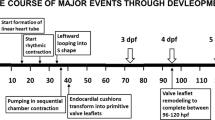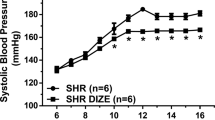Abstract
Angiotensin II (ANG II) is a powerful vasoconstrictor of the renin–angiotensin system (RAS) that plays an important role in cardiovascular regulation in adult and developing vertebrates. Knowledge of ANG II’s contribution to developmental cardiovascular function comes from studies in fetal mammals and embryonic chickens. This is the first study to examine the role of ANG II in cardiovascular control in an embryonic reptile, the American alligator (Alligator mississippiensis). Using chronic low (~ 5-mg kg embryo−1), or high doses (~ 450-mg kg embryo−1) of captopril, an angiotensin-converting enzyme (ACE) inhibitor, we disrupted the RAS and examined the influence of ANG II in cardiovascular function at 90% of embryonic development. Compared to embryos injected with saline, mean arterial pressure (MAP) was significantly reduced by 41 and 72% under low- and high-dose captopril treatments, respectively, a greater decrease in MAP than observed in other developing vertebrates following ACE inhibition. Acute exogenous ANG II injection produced a stronger hypertensive response in low-dose captopril-treated embryos compared to saline injection embryos. However, ACE inhibition with the low dose of captopril did not change adrenergic tone, and the ANG II response did not include an α-adrenergic component. Despite decreased MAP that caused a left shifted baroreflex curve for low-dose captopril embryos, ANG II did not influence baroreflex sensitivity. This study demonstrates that ANG II contributes to cardiovascular function in a developing reptile, and that the RAS contributes to arterial blood pressure maintenance during development across multiple vertebrate groups.



Similar content being viewed by others
References
Altimiras J, Franklin CE, Axelsson M (1998) Relationships between blood pressure and heart rate in the saltwater crocodile Crocodylus porosus. J Exp Biol 201(15):2235–2242
Berger PJ, Evans BK, Smith DG (1980) Localization of baroreceptors and gain of the baroreceptor-heart rate reflex in the lizard Trachydosaurus Rugosus. J Exp Biol 86(1):197–209
Bottari SP, de Gasparo M, Steckelings UM, Levens NR (1993) Angiotensin II receptor subtypes: characterization, signalling mechanisms, and possible physiological implications. Front Neuroendocrin 14(2):123–171
Brooks VL, Reid IA (1986) Interaction between angiotensin II and the baroreceptor reflex in the control of adrenocorticotropic hormone secretion and heart rate in conscious dogs. Circ Res 58(6):816–828
Brown SR, Stevens GA, Todt MJ (1983) Systemic and renal effects of angiotensin II in the freshwater turtle Pseudemys scripta elegans. Am J Physiol Reg Int Comp Physiol 245(6):R837–R842
Crossley DA II, Burggren WW, Altimiras J (2003a) Cardiovascular regulation during hypoxia in embryos of the domestic chicken Gallus gallus. Am J Physiol Regul Integr Comp Physiol 284(1):R219-226
Crossley DA II, Hicks JW, Altimiras J (2003b) Ontogeny of baroreflex control in the American alligator Alligator mississippiensis. J Exp Biol 206(16):2895–2902
Crossley DA II, Hicks JW, Altimiras J (2003c) Ontogeny of baroreflex control in the American alligator Alligator mississippiensis. J Exp Biol 206:2895–2902
Crossley DA II, Altimiras J (2005) Cardiovascular development in embryos of the American alligator Alligator mississippiensis: effects of chronic and acute hypoxia. J Exp Biol 208(Pt 1):31–39
Crossley DA II, Burggren WW (2009) Development of cardiac form and function in ectothermic sauropsids. J Morphol 270(11):1400–1412
Crossley D II, Jonker S, Hicks J, Thornburg K (2010) Maturation of the angiotensin II cardiovascular response in the embryonic White Leghorn chicken (Gallus gallus). J Comp Physiol B 180(7):1057–1065
Crossley DA II, Altimiras J (2012) Effect of selection for commercially productive traits on the plasticity of cardiovascular regulation in chicken breeds during embryonic development. Poult Sci 91(10):2628–2636
Daïkha-Dahmane F, Levy-Beff E, Jugie M, Lenclen R (2006) Foetal kidney maldevelopment in maternal use of angiotensin II type I receptor antagonists. Pediatr Nephrol 21(5):729–732
Deeming DC, Ferguson MWJ (1989) Effects of incubation temperature on growth and development of embryos of Alligator mississippiensis. J Comp Physiol B 159:183–193
Dendorfer A, Thornagel A, Raasch W, Grisk O, Tempel K, Dominiak P (2002) Angiotensin II induces catecholamine release by direct ganglionic excitation. Hypertension 40(3):348–354
Düsing R, Kayser G, Wagner S, Scherf H, Glänzer K, Predel H-G, Kramer HJ (1987) Baroreflex setting and sensitivity in normal subjects: effects of pharmacologic inhibition of the angiotensin I converting enzyme. Am J Cardiol 59(10):D50–D54
Eme J, Altimiras J, Hicks JW, Crossley DA II (2011a) Hypoxic alligator embryos: chronic hypoxia, catecholamine levels and autonomic responses of in ovo alligators. Comp Biochem Physiol A 160(3):412–420
Eme J, Crossley DA, Hicks JW (2011b) Role of the left aortic arch and blood flows in embryonic American alligator (Alligator mississippiensis). J Comp Physiol B 181(3):391–401
Eme J, Hicks JW, Crossley DA II (2011c) Chronic hypoxic incubation blunts a cardiovascular reflex loop in embryonic American alligator (Alligator mississippiensis). J Comp Physiol B 181(7):981–990
Eme J, Rhen T, Tate K, Gruchalla K, Kohl Z, Slay C, Crossley DA II (2013) Plasticity of cardiovascular function in snapping turtle embryos (Chelydra serpentina): chronic hypoxia alters autonomic regulation and gene expression. Am J Physiol Reg Int Comp Physiol 304:R966–R979
Esteves CA, Burckhardt PL, Breno MC (2012) Presence of functional angiotensin II receptor and angiotensin converting enzyme in the aorta of the snake Bothrops jararaca. Life Sci 91(19–20):944–950
Farrell DM, Wei C-C, Tallaj J, Ardell JL, Armour JA, Hageman GR, Bradley WE, Dell’Italia LJ (2001) Angiotensin II modulates catecholamine release into interstitial fluid of canine myocardium in vivo. Am J Physiol Heart Circ Physiol 281(2):H813–H822
Ferguson MWJ (1985) Reproductive biology and embryology of the crocodilians. In: Gans C, Billet F, Maderson P (eds) Biology of the reptilia, vol 14. Wiley, New York, pp 329–491
Friberg P, Sundelin B, Bohman S-O, Bobik A, Nilsson H, Wickman A, Gustafsson H, Petersen J et al (1994) Renin–angiotensin system in neonatal rats: induction of a renal abnormality in response to ACE inhibition or angiotensin II antagonism. Kidney Int 45(2):485–492
Garner MG, Phippard AF, Fletcher PJ, Maclean JM, Duggin GG, Horvath JS, Tiller DJ (1987) Effect of angiotensin II on baroreceptor reflex control of heart rate in conscious baboons. Hypertension 10(6):628–634
Guo GB, Abboud FM (1984) Angiotensin II attenuates baroreflex control of heart rate and sympathetic activity. Am J Physiol Heart Circ Physiol 246(1):H80–H89
Harrison-Bernard LM (2009) The renal renin–angiotensin system. Adv Physiol Educ 33(4):270–274
Hatton R, Clough D, Faulkner K, Conway J (1981) Angiotensin-converting enzyme inhibitor resets baroreceptor reflexes in conscious dogs. Hypertension 3(6):676–681
JÓ§hren O, Dendorfer A, Dominiak P (2004) Cardiovascular and renal function of angiotensin II type-2 receptors. Cardiovasc Res 62(3):460–467
Lee WB, Lumbers ER (1981) Angiotensin and the cardiac baroreflex response to phenylephrine. Clin Exp Pharmacol P 8(2):109–117
Lumbers ER, Kingsford NM, Menzies RI, Stevens AD (1992) Acute effects of captopril, an angiotensin-converting enzyme inhibitor, on the pregnant ewe and fetus. Am J Physiol Reg Int Comp Physiol 262(5):R754–R760
Martinovic J, Benachi A, Laurent N, Daïkha-Dahmane F, Gubler MC (2001) Fetal toxic effects and angiotensin-II-receptor antagonists. Lancet 358(9277):241–242
Matsumura Y, Hasser EM, Bishop VS (1989) Central effect of angiotensin II on baroreflex regulation in conscious rabbits. Am J Physiol Reg Int Comp Physiol 256(3):R694–R700
Mueller CA, Crossley DA II, Burggren WW (2014) The actions of the renin–angiotensin system on cardiovascular and renal development in embryonic chickens (Gallus gallus domesticus). Comp Biochem Physiol A 178:37–45
Mueller CA, Burggren WW, Crossley DA II (2013) Angiotensin II and baroreflex control of heart rate in embryonic chickens (Gallus gallus domesticus). Am J Physiol Reg Int Comp Physiol 305:R855–R863
Nishimura H, Nakamura Y, Sumner RP, Khosla MC (1982) Vasopressor and depressor actions of angiotensin in the anesthetized fowl. Am J Physiol Heart Circ Physiol 242(3):H314–H324
Reid I (1996) Angiotensin II and baroreflex control of heart rate. Physiology 11(6):270–274
Robillard JE, Nakamura KT (1988) Neurohormonal regulation of renal function during development. Am J Physiol Renal Physiol 254(6):F771–F779
Robillard JE, Weismann DN, Gomez RA, Ayres NA, Lawton WJ, VanOrden DE (1983) Renal and adrenal responses to converting-enzyme inhibition in fetal and newborn life. Am J Physiol Reg Int Comp Physiol 244(2):R249–R256
Segar JL, Merrill DC, Robillard JE (1994) Role of endogenous ANG II on resetting arterial baroreflex during development. Am J Physiol Heart Circ Physiol 266(1):H52–H59
Siegel SR, Fisher DA (1980) Ontogeny of the renin–angiotensin–aldosterone system in the fetal and newborn lamb. Pediatr Res 14(2):99–102
Silldorff EP, Stephens GA (1992) Effects of converting enzyme inhibition and α receptor blockade on the angiotension pressor response in the American alligator. Gen Comp Endocrinol 87(1):134–140
Tate KB, Eme J, Swart J, Conlon JM, Crossley DA II (2012) Effects of dehydration on cardiovascular development in the embryonic American alligator (Alligator mississipiensis). Comp Biochem Physiol A 162:252–258
Tate KB, Rhen T, Eme J, Kohl ZF, Crossley J, Elsey RM, Crossley DA (2016) Periods of cardiovascular susceptibility to hypoxia in embryonic American alligators (Alligator mississippiensis). Am J Physiol Reg Int Comp Physiol 310(11):R1267–R1278
Tufro-McReddie A, Romano LM, Harris JM, Ferder L, Gomez RA (1995) Angiotensin II regulates nephrogenesis and renal vascular development. Am J Physiol Renal Physiol 269(1):F110–F115
Acknowledgements
The study was supported by the National Science Foundation (Career award IBN IOS-0845741 to DAC).
Author information
Authors and Affiliations
Corresponding author
Additional information
Communicated by H. V. Carey.
Rights and permissions
About this article
Cite this article
Mueller, C.A., Eme, J., Tate, K.B. et al. Chronic captopril treatment reveals the role of ANG II in cardiovascular function of embryonic American alligators (Alligator mississippiensis). J Comp Physiol B 188, 657–669 (2018). https://doi.org/10.1007/s00360-018-1157-2
Received:
Revised:
Accepted:
Published:
Issue Date:
DOI: https://doi.org/10.1007/s00360-018-1157-2




